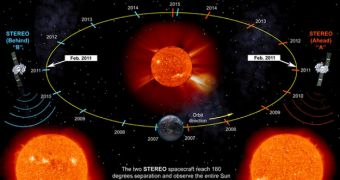Officials at the American space agency say that a solar observatory NASA operates will provide the first full view of the Sun in early February. Both the near and the far sides of the star will be imaged at the same time, the experts add.
This will be made possible by the NASA STEREO (Solar TErrestrial RElations Observatory) mission, which features two identical spacecraft at different positions in orbit around the Sun. This allows their detectors to notice whatever is going on from different angles.
Generally, the two components are orbiting the Sun in an Earth-like orbit, traveling ahead and behind the planet, respectively. This provides NASA experts with a 3D view of phenomena on the Sun.
But February 6 will mark the date when the two observatories of the STEREO mission will be in positions opposite to each other, on either side of the star. This means that the entire 360 degrees of the Sun will be seen simultaneously, the first time this will ever be achieved.
“For the first time in the history of humankind we will be able to see the front and the far side of the Sun,” NASA HQ STEREO program scientist Madhulika Guhathakurta tells Universe Today.
“This will be the first time we can see the entire Sun at one time,” adds NASA solar astrophysics expert Dean Pesnell, who is a project scientist with the Solar Dynamics Observatory.
The SDO, which is managed by the NASA Goddard Spaceflight Center (GSFC), in Greenbelt, Maryland, is another solar observatory, that looks at the Sun in extreme ultraviolet (EUV) wavelengths.
The main objective of the STEREO mission is to analyze the nature of coronal mass ejections (CME), violent eruptions on the surface of the Sun that can cause dangerous solar flares. Upon reaching Earth, these can cause extensive damage to satellites and power grids.
Therefore, STEREO is also aiding with space weather forecast. It is one of the first spacecraft ever to do so, researchers operating it say. Now, it will also provide NASA with a groundbreaking first.
“Until now there has always been an unseen part of the Sun. Although that unseen part has always rotated into view within a week or two, a global model must include all of the Sun to understand where the magnetic field goes through the surface,” Pesnell explains.
“Also, from the Earth we can see only one pole of the Sun at a time, while with STEREO we can see both poles at the same time,” the researcher goes on to say.
“The next few years of overlapping coronal images will be a goldmine of information for predicting space weather at the Earth and understanding of how the Sun works,” he adds.
“It is like getting the GOES images of the Earth for the first time. We haven’t missed a hurricane since, and now we won’t miss an active region on the Sun,” Pesnell concludes.

 14 DAY TRIAL //
14 DAY TRIAL //